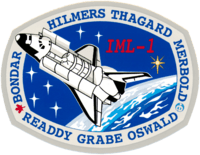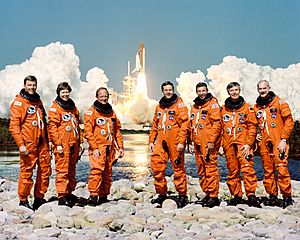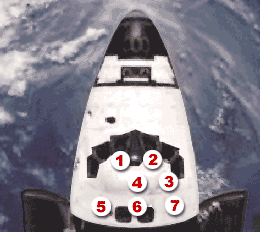STS-42 facts for kids

Spacelab Module LM2 in Discovery's payload bay, serving as the International Microgravity Laboratory (IML).
|
|
| Names | Space Transportation System-45 |
|---|---|
| Mission type | Microgravity research |
| Operator | NASA |
| Mission duration | 8 days, 1 hour, 14 minutes, 44 seconds (achieved) |
| Distance travelled | 4,701,140 km (2,921,150 mi) |
| Orbits completed | 129 |
| Spacecraft properties | |
| Spacecraft | Space Shuttle Discovery |
| Launch mass | 110,400 kg (243,400 lb) |
| Landing mass | 98,924 kg (218,090 lb) |
| Payload mass | 13,066 kg (28,806 lb) |
| Crew | |
| Crew size | 7 |
| Members |
|
| Start of mission | |
| Launch date | 22 January 1992, 14:52:33 UTC |
| Rocket | Space Shuttle Discovery |
| Launch site | Kennedy Space Center, LC-39A |
| Contractor | Rockwell International |
| End of mission | |
| Landing date | 30 January 1992, 16:07:17 UTC |
| Landing site | Edwards Air Force Base, Runway 22 |
| Orbital parameters | |
| Reference system | Geocentric orbit |
| Regime | Low Earth orbit |
| Perigee | 291 km (181 mi) |
| Apogee | 307 km (191 mi) |
| Inclination | 57.00° |
| Period | 90.50 minutes |
 STS-42 mission patch  Stephen S. Oswald, Roberta L. Bondar, Norman E. Thagard, Ronald J. Grabe, David C. Hilmers, Ulf D. Merbold, William F. Readdy |
|
STS-42 was a NASA Space Shuttle mission using the orbiter Discovery. This flight carried a special laboratory called Spacelab into space. The main goal of the mission was to study how microgravity affects different living things and materials.
Discovery was supposed to launch on January 22, 1992, but bad weather caused a delay. It successfully lifted off an hour later. The mission lasted for 8 days, 1 hour, 14 minutes, and 44 seconds. The shuttle landed safely at Edwards Air Force Base in California on January 30, 1992. STS-42 was the first of two Discovery flights in 1992. It was also the last Discovery mission with seven crew members until 1997.
Contents
Meet the Crew
| Position | Astronaut | |
|---|---|---|
| Commander | Third spaceflight |
|
| Pilot | First spaceflight |
|
| Mission Specialist 1 | Fourth spaceflight |
|
| Mission Specialist 2 | First spaceflight |
|
| Mission Specialist 3 | Fourth and last spaceflight |
|
| Payload Specialist 1 | Only spaceflight |
|
| Payload Specialist 2 | Second spaceflight |
|
Where the Crew Sat
The crew had specific seats for launch and landing. Seats 1 to 4 were on the Flight Deck, which is like the cockpit. Seats 5 to 7 were on the Middeck, a living and working area.
| Seat | Launch | Landing |
Seats 1–4 are on the Flight Deck. Seats 5–7 are on the Middeck. |
|---|---|---|---|
| S1 | Grabe | Grabe | |
| S2 | Oswald | Oswald | |
| S3 | Thagard | Hilmers | |
| S4 | Readdy | Readdy | |
| S5 | Hilmers | Thagard | |
| S6 | Bondar | Bondar | |
| S7 | Merbold | Merbold |
Mission Highlights
The STS-42 mission launched on January 22, 1992. The launch was delayed by one hour because of weather conditions. The Discovery shuttle weighed about 110,400 kilograms (243,396 pounds) at launch.
The International Microgravity Laboratory
Discovery carried the International Microgravity Laboratory-1 (IML-1) into orbit. This was a special Spacelab module where astronauts could work. Its main purpose was to study the effects of weightlessness on living things and how materials behave in space.
The crew was divided into two teams, Red and Blue. They worked on many experiments. Some experiments looked at how the human body, especially the nervous system, adapts to low gravity. Other experiments studied how microgravity affected different life forms. These included shrimp eggs, lentil seedlings, fruit fly eggs, and bacteria.
Experiments with Materials
The astronauts also conducted experiments on how materials grow crystals in low gravity. They grew crystals from substances like enzymes, mercury iodine, and even a virus.
Other Payloads
Besides the main laboratory, the shuttle carried other items. These included 10 "Get Away Special" (GAS) canisters. These are small containers for experiments. There were also experiments from the Shuttle Student Involvement Program (SSIP). An Australian-made ultraviolet telescope called Endeavour was also on board. Other experiments focused on things like how gels form in space and how to process polymer membranes. They also measured radiation in space.
Landing and Return
The mission was extended by one day so the crew could do more science. Discovery landed on January 30, 1992, at Edwards Air Force Base. The shuttle rolled for about 2,990 meters (9,811 feet) after landing. It weighed about 98,924 kilograms (218,016 pounds) when it landed. The orbiter was then returned to the Kennedy Space Center on February 16, 1992.
Mission Insignia
The mission patch, or insignia, has a special meaning. The four stars in the lower blue part and two stars in the upper blue part represent the mission's number, STS-42. The single gold star above the horizon on the right honors astronaut Manley Lanier "Sonny" Carter Jr.. He was originally going to be part of the STS-42 crew but sadly passed away in a plane crash.




